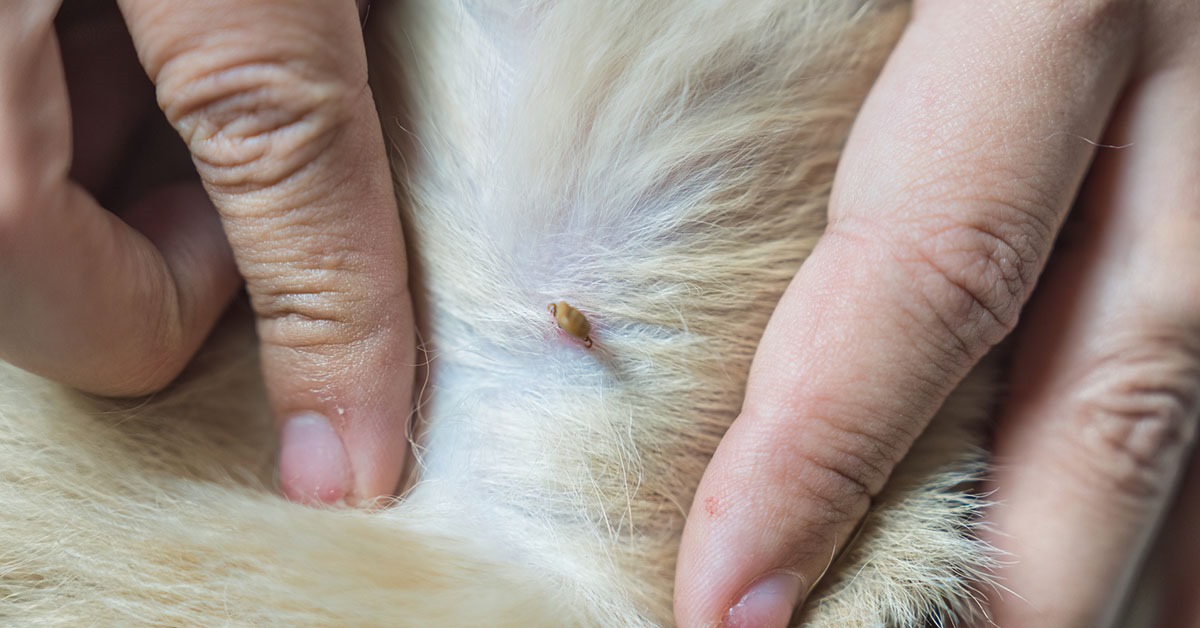Ticks pose a significant threat to dogs’ health and well-being. When left untreated, these tiny parasites can spread diseases like Lyme disease and Rocky Mountain spotted fever. As responsible pet owners, we need to take proactive measures to protect our dogs from ticks. Therefore, in this blog post, we’ll explore how to prevent ticks on dogs, including identifying signs of infestation and effective preventive measures. Let’s get started.
What Are Ticks in Dogs?

The tick is an arachnid parasite that feeds on blood. They’re external parasites, which means they live outside their host’s body. These ticks have specialized mouthparts for attaching firmly to the skin and feeding on blood. It can cause discomfort and transmit diseases when a tick attaches to a dog.
Types of Ticks in Dogs
- American Dog Tick (Dermacentor variabilis): Found in North America, this tick can transmit diseases like Rocky Mountain Spotted Fever and Tularemia. It prefers areas with dense vegetation and tall grass.
- Brown Dog Tick (Rhipicephalus sanguineus): Unlike other tick species, brown dog ticks can complete their life cycle indoors. They’re common in kennels, homes, and other indoor places. The brown dog tick can spread diseases like ehrlichiosis and babesiosis.
- Black-Legged Tick (Ixodes scapularis): This tick carries Lyme disease, anaplasmosis, and babesiosis. It is found mainly in wooded areas in the spring and fall.
Signs of Tick Infestation

The early detection of tick infestations in dogs is essential for timely treatment. Ticks are small, but they can have an impact on a dog’s health. You may notice these signs in your dog:
Excessive Scratching
Dogs with tick infestations are likely to scratch or bite at affected areas more than usual. Tick bites commonly cause this behavior to relieve discomfort.
Visible Ticks
Sometimes, ticks are visible to the naked eye, especially in areas with less hair, like the ears, groin, and between the toes. You should check your dog regularly for ticks after outdoor activities.
Redness and Swelling
The bite site can become inflamed, resulting in redness, swelling, and irritation. A tick bite could cause an allergic reaction or secondary infection.
Lethargy and Fever
If ticks transmit diseases to dogs or when severe infestations occur, symptoms may include lethargy, weakness, and fever. You should seek immediate veterinary attention if you notice these systemic signs.
Unexplained Pain or Lameness
Some tick-borne diseases can cause joint pain, lameness, and reluctance to move in dogs. If your dog shows signs of discomfort or limping without a clear cause, take him to a vet.
Enlarged Lymph Nodes
The swelling of lymph nodes, particularly near tick attachment sites, indicates a tick-borne infection.
You need to recognize these signs early and seek vet care right away to prevent tick-borne diseases from spreading to your dog. Ultimately, monitoring your dog’s health and checking for ticks regularly can help mitigate tick exposure risks.
How to Prevent Ticks on Dogs
The best way to prevent ticks from infesting your dog is to combine proactive measures with regular maintenance. Follow these preventive strategies to reduce tick infestations and protect your pup:
Regular Grooming
Maintain a grooming routine that involves thoroughly inspecting your dog’s coat and skin. Check your pet for ticks with a fine-toothed comb or your fingers, paying particular attention to areas with less fur, like the ears, groin, and between toes. If you find a tick, remove it right away with tweezers, making sure you grasp it close to your skin to avoid leaving mouthparts behind.
Use of Tick Preventives
Your veterinarian can advise you on the best tick-prevention products for your dog. Treatment options include topical spot-on treatments, tick collars, oral medications, and repellent sprays. These repel ticks or kill them when your dog comes into contact with them. Make sure you follow your vet’s or the product manufacturer’s instructions for application and reapplication.
Environmental Control
You can minimize tick habitats by altering the environment outside. You should keep grass and vegetation short, remove leaf litter, and build a buffer zone between wooded areas and your living space. Make sure you use environmentally safe tick control products in areas where dogs are likely to wander, such as along trails or in wooded areas.
Tick-Resistant Clothing
If your dog is going into tick-prone territory, make sure he’s wearing tick-resistant clothing. Tick-repellent vests, bandanas, or socks add an extra layer of protection. If you can, avoid walking your dog in tall grass or dense vegetation where ticks are plentiful.
Vaccination
Ask your vet about vaccination options if tick-borne diseases are prevalent in your area. Vaccines for diseases like Lyme disease and canine ehrlichiosis can boost your dog’s immune system. Don’t forget that vaccines aren’t a substitute for other preventive measures, but they can complement them.
Regular Veterinary Check-ups
Check-in with your vet regularly to monitor your dog’s health and discuss tick prevention. Your vet can give you recommendations based on your dog’s age, lifestyle, and tick exposure risk. Furthermore, they can screen for tick-borne diseases during wellness exams to catch infections early.
Finally, these comprehensive preventive measures can effectively protect your dog from tick-borne diseases.
FAQs
How do I stop ticks from getting on my dog?
Use a veterinarian-recommended flea and tick preventative monthly to protect your dog from tick bites and tick-borne diseases. Check your dog’s fur and skin regularly for ticks, especially after outdoor activities, and remove any ticks you find immediately. Furthermore, an effective household spray that targets ticks and their habitats should be used. Taking these preventive measures will ensure your dog’s health and safety against tick-borne diseases.
What kills ticks on dogs immediately?
Currently, no method kills ticks on dogs immediately. Use fine-tipped tweezers to grasp the tick and pull it straight out with steady pressure. Do not squeeze the tick’s body, as this will let more saliva into the wound.
After removing the bite, wash your hands and disinfect the area. Ask your vet about tick prevention and safe tick removal techniques.
Can I spray lemon juice on my dog for ticks?
Lemon juice has some natural repellent properties, but it’s not recommended for tick prevention in dogs. When applied to a dog’s skin, lemon juice can cause irritation or allergic reactions. Furthermore, it’s not as effective at repelling ticks as veterinarian-recommended tick preventives. The best tick prevention options are tailored to your dog’s needs and lifestyle, so speak with your vet.
What essential oils keep ticks off dogs?
Several essential oils have tick-repellent properties and can help keep ticks off dogs. Here are some essential oils you can use:
- Lavender oil: Known for its calming properties, lavender oil also has natural insect-repellent qualities.
- Cedarwood oil: Cedarwood oil has a strong scent that repels ticks and other insects.
- Eucalyptus oil: Eucalyptus oil contains compounds that are effective in repelling ticks and can be diluted and applied to a dog’s collar or bedding.
- Peppermint oil: Peppermint oil has a strong scent that ticks find unpleasant, making it an effective natural repellent.
If you’re using essential oils on dogs, mix them properly and don’t apply them directly to the skin. If your dog has any underlying health conditions or sensitivities, consult your vet first.
Read More: Why Does My Dog Stink
The Takeaway
Mastering how to prevent ticks on dogs is more than a precaution—it’s a commitment to their health. Staying proactive and informed about tick-borne threats doesn’t just protect you from parasites; it nurtures a bond built on trust. With vigilance and proactive care, you can enjoy many tick-free adventures with your pet. Maintain your dog’s tick prevention regimen for a healthier, happier life together.




